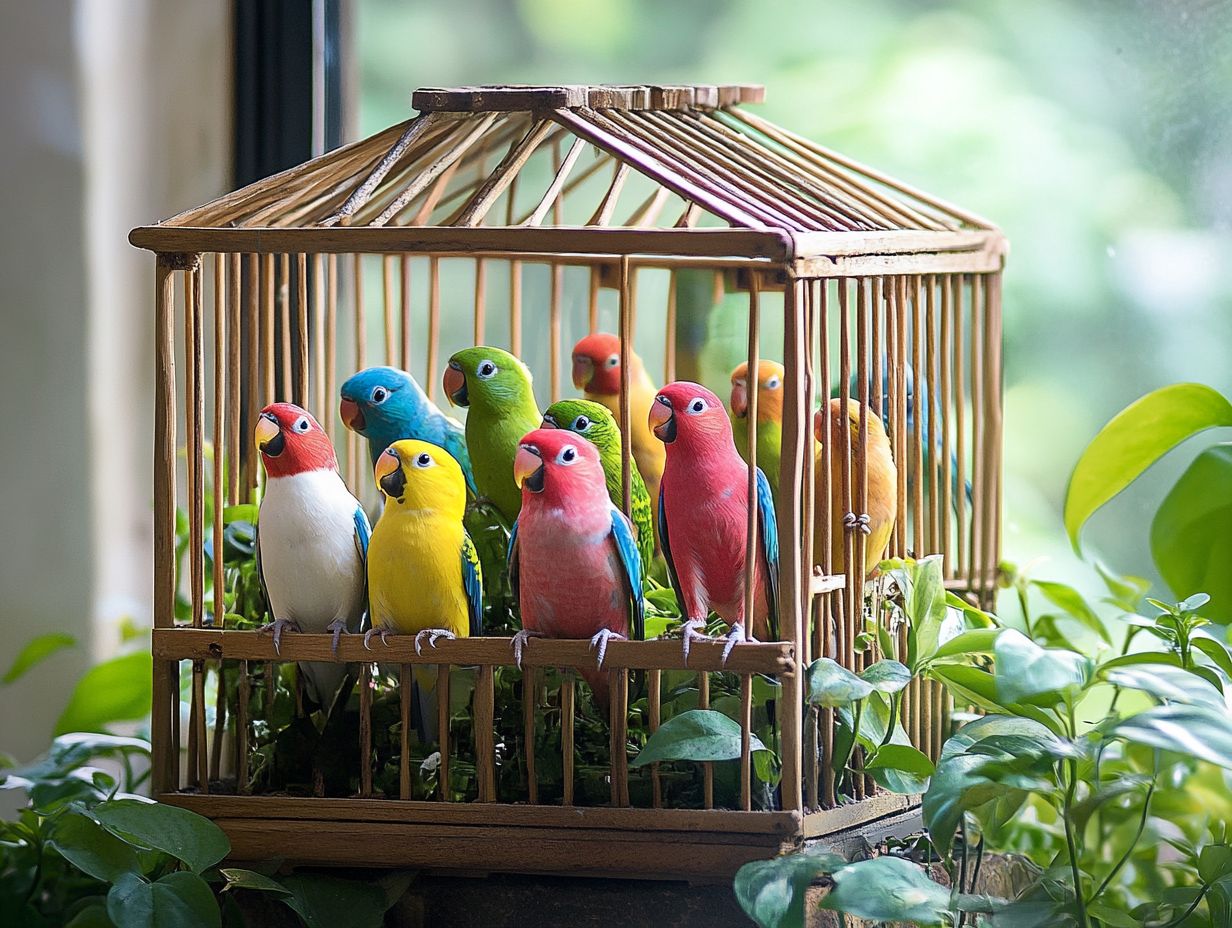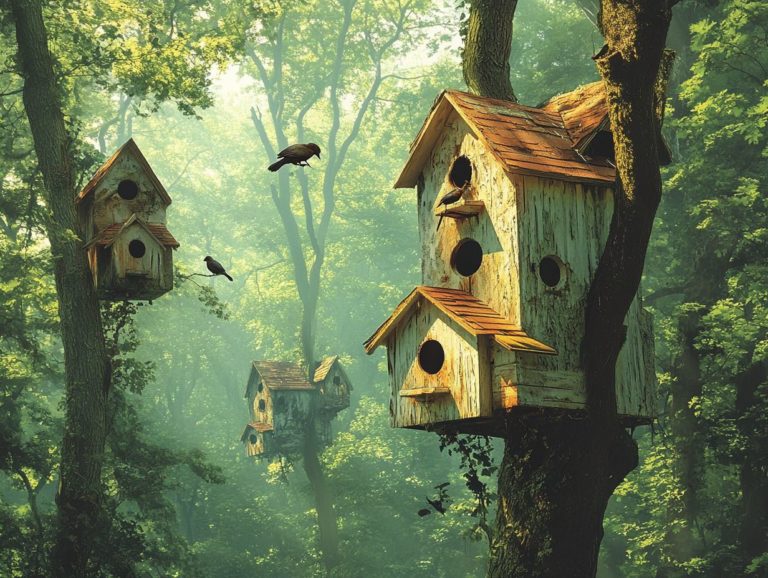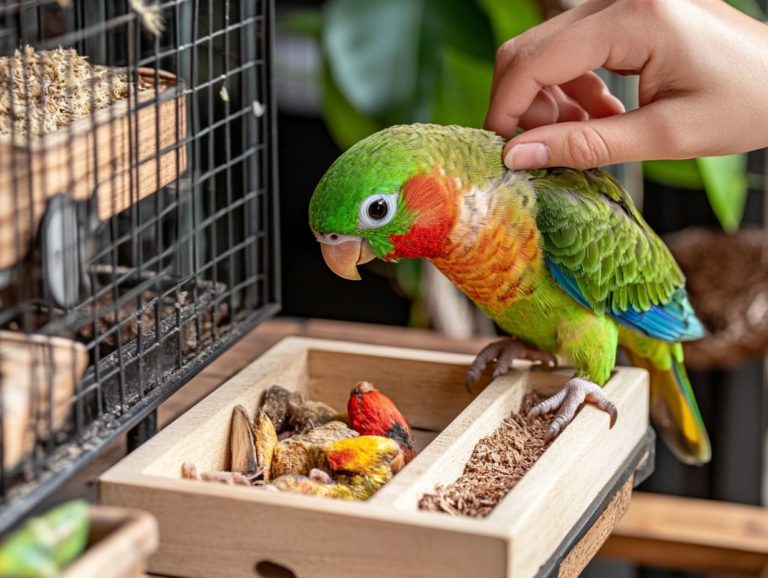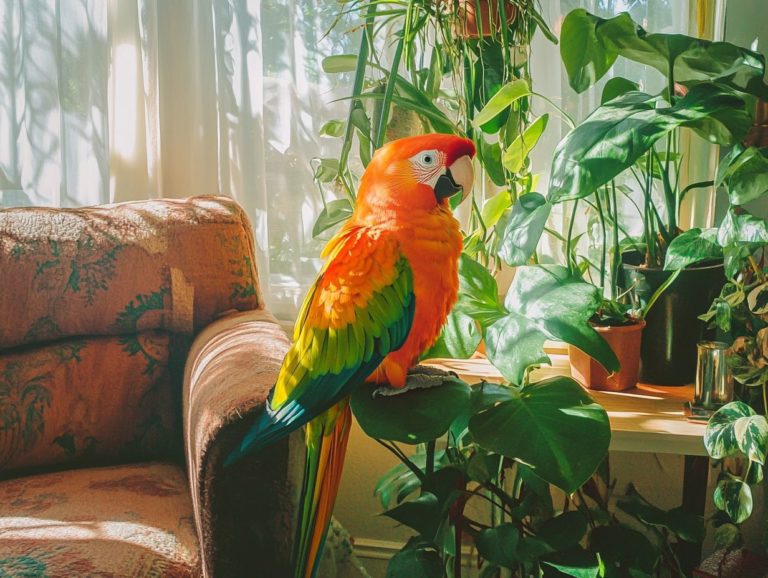The Benefits of Natural Materials in Bird Cages
When creating a safe and nurturing environment for your feathered friends, the choice of materials in their cages is crucial.
This article explores the advantages of using natural materials. These materials significantly enhance the comfort and health of your birds while minimizing environmental impact.
From safe options to practical tips on maintenance, you ll discover how embracing natural materials can transform your bird cage into a true haven for your avian companions.
Contents
- Key Takeaways:
- Benefits of Using Natural Materials in Bird Cages
- Types of Natural Materials to Use
- How to Incorporate Natural Materials in Bird Cages
- Maintaining and Cleaning Bird Cages with Natural Materials
- Frequently Asked Questions
- What are the benefits of using natural materials in bird cages?
- What types of natural materials can be used in bird cages?
- How do natural materials benefit a bird’s health?
- Are there any environmental benefits to using natural materials in bird cages?
- Do natural materials require special care in bird cages?
- Can natural materials be used in all types of bird cages?
Key Takeaways:

- Natural materials in bird cages enhance comfort and promote better health for birds, making them happier and more active.
- Using natural materials in bird cages reduces environmental impact and supports sustainable practices.
- Safe and effective types of natural materials include wood, grass, and natural fibers. Consider using safe plants and learning to identify toxic plants for a healthy environment.
What are Natural Materials?
Natural materials are organic substances sourced directly from nature, untouched by processing or chemical alterations. They are essential for various applications, especially in ensuring the health and comfort of pets like birds.
In vibrant cities like Orlando and Austin, utilizing local resources such as crepe myrtle and other native trees can significantly benefit birds, such as the umbrella cockatoo, while promoting sustainable pet ownership and environmental stewardship.
Natural materials come from plants, minerals, and fibers. They provide options that fit the needs of different bird species. For instance, using untreated wood for perches ensures comfort and contributes to beak health. Natural fibers from sisal can also enrich their playtime activities.
The significance of natural materials goes beyond health; they play a vital role in mental stimulation. Engaging birds’ instincts fosters emotional well-being, which is particularly important for species like the umbrella cockatoo.
By choosing organic materials, you make a thoughtful choice that benefits both your feathered companions and the planet, nurturing a deeper connection to nature.
Benefits of Using Natural Materials in Bird Cages
The advantages of incorporating natural materials into bird cages are numerous. They elevate both the well-being of your feathered friends and contribute to a more sustainable environment, especially when considering the benefits of a multi-level bird cage.
By choosing natural materials, you can source items from local nurseries, like crepe myrtle branches and other natural branches. This ensures a safe habitat, reducing the risk of diseases and exposure to toxic plants.
This smart choice creates a happier, healthier home for birds like the umbrella cockatoo, allowing them to thrive in an environment that mirrors their natural habitat.
Enhanced Comfort and Health for Birds
Using natural materials in bird cages significantly enhances the comfort and health of your feathered friends. It creates a more familiar and stress-free environment. For example, branches from safe plants like crepe myrtle serve as perches that mimic their natural habitats, encouraging species such as the umbrella cockatoo to engage in instinctual behaviors.
These natural elements not only function as practical perches but also add visual interest and stimulation. These aspects are vital for their mental well-being. Incorporating materials like untreated wood and coconut shells encourages exploration and play, further enriching your bird s cognitive engagement.
Natural fibers can aid in proper beak and nail maintenance, contributing to their overall health. It s crucial to prioritize safe plant choices, ensuring that the materials in your pets’ environments are non-toxic and beneficial.
By thoughtfully selecting these materials, you create a nurturing space that supports both the physical and emotional well-being of your avian companions.
Don t wait! Make your bird’s home healthier today by choosing natural materials!
Reduced Environmental Impact

Using natural materials in bird cages significantly lessens the environmental impact tied to pet care. By sourcing materials from local nurseries and committing to sustainable practices, you support your community and provide your birds, like the umbrella cockatoo, with an eco-friendly habitat.
Embracing these eco-conscious choices nurtures a healthier planet, free from the synthetic pollutants that often accompany conventional pet supplies. For example, opting for untreated wood or fabrics that break down naturally and won’t harm the environment minimizes waste and aligns your pet care with sustainable living ideals. Natural materials are typically safer for your pets, reducing their exposure to harmful toxins.
The ripple effect of these decisions underscores the importance of being mindful in responsible pet ownership, where the well-being of both pets and the planet takes center stage. This approach fosters a lasting commitment to environmental stewardship, extending your influence beyond pet care into broader eco-friendly practices.
Types of Natural Materials to Use
When choosing natural materials for bird cages, you have an array of options that prioritize both safety and comfort for your feathered friends, including various plants that can enhance their living space.
Consider crepe myrtle branches; they’re non-toxic and require minimal maintenance. This makes them ideal for perches. Incorporating a selection of safe plants enriches the living environment for birds, including the charming umbrella cockatoo.
Safe and Effective Options
Safe and effective options for natural materials in bird cages include a variety of non-toxic plants and branches. For instance, branches from crepe myrtle trees make excellent perches, perfect for accommodating birds like the umbrella cockatoo.
Learn which plants are safe to keep your birds happy and healthy! Incorporating branches from apple or willow trees can greatly enrich your bird’s habitat. These additions provide opportunities for chewing and climbing activities that are essential for both mental stimulation and physical health. Non-toxic choices like bamboo and untreated pine are superb options for constructing cages or play structures.
Prioritizing these materials supports your birds natural behaviors while minimizing the risk of harmful exposure to chemicals. By selecting these safe, natural options, you can create an inviting and secure space where your feathered friends can truly thrive.
How to Incorporate Natural Materials in Bird Cages
Incorporating natural materials into bird cages demands thoughtful planning and a solid grasp of safe options that elevate the birds’ habitat. You can creatively integrate branches from trees such as crepe myrtle, along with safe plants, to cultivate a stimulating environment.
Don’t forget! Regular maintenance is key to keeping your birds happy and healthy. It’s important to keep maintenance in mind to ensure both cleanliness and the well-being of your feathered companions.
Tips and Techniques for Using Natural Materials

When you use natural materials in bird cages, adhering to specific tips and techniques can significantly enhance both your bird’s comfort and the overall aesthetic of the space. Regular maintenance practices, such as cleaning with safe solutions like vinegar and ensuring adequate sunlight exposure, can keep the environment healthy and inviting for your feathered companions, such as the umbrella cockatoo.
To truly maximize the benefits of natural materials, think about incorporating items like untreated wood perches, coconut shells, and sisal ropes. These additions offer texture and serve a practical purpose. Arranging these materials creatively encourages your birds to explore and play, allowing them to engage their natural instincts.
Remember to inspect these elements regularly for signs of wear and tear, replacing any that show damage to ensure their safety. Positioning the cage in an area where it receives indirect sunlight can help maintain an optimal environment for your birds, such as the umbrella cockatoo, while also promoting natural behaviors and providing essential warmth.
Maintaining and Cleaning Bird Cages with Natural Materials
Maintaining and cleaning bird cages made from natural materials is essential for preventing diseases and ensuring your birds’ health. Your cleaning regimen should incorporate safe methods, such as bleach and vinegar solutions, to effectively eliminate harmful fungi and bacteria while also preserving the integrity of materials like crepe myrtle branches.
By prioritizing these practices, you create a healthier environment for your feathered companions.
Top Tips for a Sparkling Clean Bird Cage!
To keep your bird cage materials lasting longer, follow best practices for maintenance and hygiene. Regular cleaning with cleaning products that are safe for the environment and inspecting for any signs of diseases or pests, such as fungi, will help you maintain a healthy habitat for your birds, like the umbrella cockatoo.
Consider replacing bedding materials, such as untreated wood shavings or paper, weekly to prevent mold and bacteria growth. Wipe down the cage surfaces regularly with a solution of water and vinegar to keep it sparkling clean!
Rotate and vary toys made of natural wood to keep your birds engaged and to prevent wear and tear on the cage’s structure. Schedule periodic deep cleans for thorough inspections of the cage s integrity, reducing the risk of infestations or illness.
Frequently Asked Questions
What are the benefits of using natural materials in bird cages?

Using natural materials in bird cages can provide a more comfortable and natural environment for birds. These materials can also offer the benefits of natural perches for birds and are more environmentally friendly.
What types of natural materials can be used in bird cages?
- Wood
- Bamboo
- Natural fibers
- Non-toxic plants such as seagrass
It is important to choose materials that are safe and non-toxic for birds.
How do natural materials benefit a bird’s health?
Natural materials can provide a more stimulating environment for birds, encouraging physical activity and mental stimulation. Some materials, such as non-toxic plants, can also have anti-bacterial properties that can benefit a bird’s overall health.
Are there any environmental benefits to using natural materials in bird cages?
Yes, using natural materials in bird cages can have a lower impact on the environment compared to synthetic materials. Natural materials are often biodegradable and sustainable, making them a more eco-friendly choice.
Do natural materials require special care in bird cages?
Natural materials may require some extra care compared to synthetic materials. For example, wood may need to be treated to prevent mold or rot, and non-toxic plants may need to be trimmed regularly to maintain their health. However, the benefits for the birds and the environment make it worth the extra effort.
Can natural materials be used in all types of bird cages?
Yes, natural materials can be used in most types of bird cages, including wire, acrylic, and mesh cages. However, it is important to consider the specific needs and behaviors of your bird when choosing materials and how they may interact with the cage structure.






